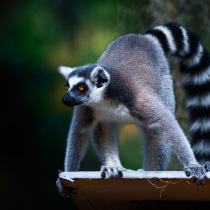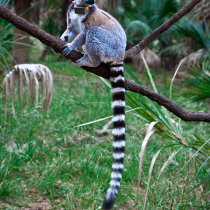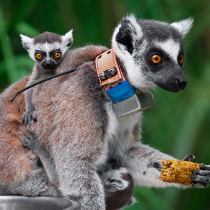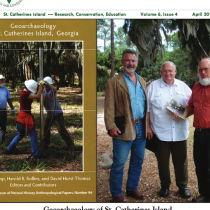The St. Catherines Island Lemur Program maintains several free-ranging troops of ring-tailed lemurs on the Island. The program supports conservation research into the behavior of these endangered lower Primates.
Ring-tailed lemurs are endemic to the southwestern region of the island of Madagascar off the southwest coast of Africa. The New York Zoological Society (now the Wildlife Conservation Society) introduced the species on St. Catherines Island in 1984 to study breeding and troop behavior.The population on St. Catherines Island exists as the only free-ranging population outside of Madagascar.
The highly social species lives in groups, or troops, of up to 30 individuals. On St. Catherines Island, the population subdivided into six troops. Females are dominant in troops. The ring-tailed lemur reproduces readily in captivity and in this free-ranging population. Eighty-three ring-tailed lemurs inhabit St. Catherines Island (as of 18 February 2013).
The species can live up to 27 years in captivity—or 16 to 19 years in the wild. On St. Catherines Island, the oldest lemur is around 20 years old.
The International Union for Conservation of Nature Red List identifies ring-tailed lemurs as “Near Threatened” based on the assumption that the species depleted by 20–25 percent over the last 24 years due to destruction of habitat and exploitation.
Related Publications
Geoarchaeology of St. Catherines Island, Georgia
The field of geoarchaeology has typically been defined as either geology pursued within an archaeological framework or sometime the reverse, as archaeology framed with the help of geological methodology. Either way, the formalized objectives of geoarchaeology define a broad range of pursuits, from placing archaeological sites into relative and absolute temporal context through the application of stratigraphic principles and absolute dating techniques, to understanding the natural processes of site formation, to reconstructing the landscapes that existed around a site or group of sites at the time of occupation.
- Date Published : April 2011
- Read more
25th Annual Christmas Bird Count, December 17th, 2011
On Friday, December 16th, 42 birders hopped on boats at the mainland eager to get to St. Catherines and check out their assigned areas in preparation for Saturday, the 25th Christmas Bird Count (CBC) on SCI. This is part of The National Audubon Society’s 112th CBC, with the count taking place in over 2,000 locations from December 14th—January 5th.
This year was our third best count with 140 species and 33,383 individuals on count day. Four additional species were seen during count week, and the total of 144 matched (with 2002) the highest number during count-week.
- Date Published : January 2012
- Read more
After 30 Years of Animal Research, Bronx Zoo to Close Island Preserve
The Bronx Zoo has closed a large animal preserve on a 14,000-acre undeveloped island off the coast of Georgia, where for 30 years zoologists have studied – among other things – the mating habits of wildlife, including lemurs, hartebeests, zebras, tortoises, gazelles and several species of exotic birds.
- Source : The New York Times
- Date Published : December 29, 2004
- Read more
Lemurs, hartebeests, hornbills call island home
In the interior of St. Catherines Island, deer roam freely and wild hogs jog playfully throughout the woods. Suddenly, in the distance, a sound not native to the area is heard. A group of ring-tailed lemurs hangs from the trees, a small herd of African Jackson hartebeests prances by, and an exotic great hornbill bird is spotted. Welcome to the sanctuary of St. Catherines Island Wildlife Survival Center.
- Source : The Coastal Courier
- Date Published : June 8, 2009
- Read more
The Saint behind St. Catherines Island
Do you ever wonder where St. Catherines Island got its name? Recent research on artifacts recovered at Mission Santa Catalina de Guale, located on St. Catherines Island, has provided some insight into this very question. Ironically, the information regarding the name source comes to us from an object recovered on Amelia Island (Florida). There are actually four Santa Catalina de Guale missions in Spanish Florida. The earliest (Santa Catalina de Guale I), built on St. Catherines Island, was attacked in 1680 by British troops and Indian allies, probably in a slave raid. After the attack, the residents relocated to nearby Sapelo Island, establishing the second location of Mission Santa Catalina (II, 1680–1683).
- Date Published : April 2012
- Read more
Recent History of the North Pasture
Most of the Gopher Tortoises on St. Catherines Island live in North Pasture. Some have formed colonies on other parts of SCI only to return to North Pasture after a few years. Some people call North Pasture (NP) the “North Savanna”. Some have described it as a Long-leaf Pine Flat-wood and another as a managed Long-leaf Pine forest. It was Georgia’s largest stand of mature LL pine on a barrier island when the logging began (1938). Mr. Noble purchased the island in 1943. At that time loggers held timber contracts for most of the remaining timber on SCI.
- Date Published : April 2013
- Read more
Throughfall and Stemflow in the Forest Canopy
Forests provide many known ecosystem services— they clean our air, sequester our carbon emissions, protect our soils from erosion, provide habitat for species on which we rely for sport and ecotourism, and much more. While the list goes on, there are likely even more ecosystem services which have yet to be discovered. What other amazing services do forests provide to our ecosystem? That’s the question at the heart of Dr. John Van Stan’s (Fig. 1) research on St. Catherines Island. To begin answering this question, Dr. Van Stan is currently installing monitoring equipment that will allow him and his colleagues at Georgia Southern University, Skidaway Institute of Oceanography, and the Helmholtz Centre for Environmental Research (in Leipzig, Germany) to track water and nutrients as they move from the canopy into the soils and freshwater lens and, ultimately, out to the ocean. They expect to find new forest influences over each of these ecosystem components critical to barrier islands as a whole.
- Date Published : August 2012
- Read more
Survey of St. Catherines Island’s Aquatic Beetles
Students of the department of Biological and Environmental Sciences at Georgia College reveled in the opportunity to explore St. Catherines Island and its aquatic fauna with me. These students (from five countries) are currently participating in classes, including Entomology, Aquatic Entomology, and Invertebrate Zoology as well as independent research. Most of the students come fully trained with collecting and curating techniques of invertebrates and particularly beetles, and are already quite adept for our task of collecting and analyzing beetles of SCI.
- Date Published : December 2012
- Read more
Southeastern American Kestrels
In January 2012, St. Catherines Island hosted the 1st Southeastern American Kestrel Working Group meeting, led by Ken Meyer of Avian Conservation and Research Institute (ACRI). This meeting was a culmination of a planning project being facilitated by ACRI with a National Fish and Wildlife Foundation grant to understand the status of and concerns for the SE American Kestrel. Florida, Mississippi, Alabama, and Georgia state and federal personnel attended to report the status of the birds in their area, and to identify needs that each state has to learn more about the status of these Kestrels and understanding their limiting resources. Coming together as a cooperative working group gives biologists and land managers a better understanding of large-scale needs and resources of this species and their habitats.
- Date Published : February 2012
- Read more




